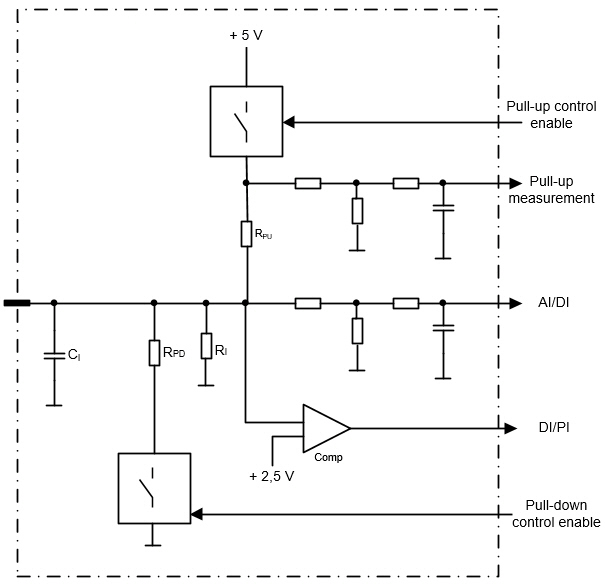AI/DI/PI_type096
Possible pin modes:
-
+5 V AI mode
-
DI mode
-
PI mode
Select the mode using MultiTool Creator. MultiTool Creator generates the needed code using functions from SafeSSeriesIODriverExt library. For more information refer to Epec Programming and Libraries Manual and MultiTool Creator Manual.
AI (analog input) mode
-
These pins have a pull-up/pull-down selection by a library function
-
Pins can be used as high impedance voltage inputs for signals from 0 to 5 volts
-
Pins can be used as e.g. joystick connection when AI mode without pull-up/pull-down is selected
-
Pins can be used as e.g. resistive temperature sensor connection when AI mode with pull-up is selected
DI (digital input) mode
-
These pins can be used as digital inputs by using an application library
-
The pin must be configured to DI mode when using it as a digital input. This enables a pull-down resistor to the ground
PI (pulse input) mode
-
This input mode has a pulse counting (PI), pulse width measuring, pulse frequency and pulse ratio features
-
These pins have a pull-up/pull-down selection by a library function
-
Pulse input mode can be used as a 1 or 2 channel pulse counter
-
1 channel pulse counter, it is possible to use a specific pin as reset channel
-
2 channel pulse counter, the reset feature is done by software. For more information refer to Epec Programming and Libraries Manual, section Programming SC52 Safety Control Units > I/O Programming > AI/DI/PI_type096
-
Possible software channels and pairs are listed in section I/O List and in Epec Programming and Libraries Manual, section Programming SC52 Safety Control Units > I/O Programming > AI/DI/PI_type096
-
This mode is also suitable for quadrature sensor position counting
Electrical characteristics
|
Symbol |
Parameter |
Conditions |
Min |
Max |
Units |
|
VI |
Input Voltage measuring range |
0 |
6 |
V |
|
|
RI |
Input Resistance |
Input high: Referenced to GND (Note 5) |
|
86 |
kΩ |
|
RPD |
Pull-down Resistance |
DI mode |
10,3 |
10,5 |
kΩ |
|
RPU |
Pull-up Resistance |
PU mode |
2,18 |
2,22 |
kΩ |
|
VIevel |
Voltage level |
Unconnected pin, no pull-up selected |
typ. 0 |
V |
|
|
Unconnected pin, pull-up selected |
typ. 4,6 |
||||
|
IE |
Input Error |
Voltage mode |
|
+/- 2 |
% |
|
BW |
Input Low Pass Filter Bandwidth (-3 dB cut-off frequency) |
Voltage mode |
1600 |
Hz |
|
|
VIH |
Input High Voltage |
PI mode |
3,6 |
34 |
V |
|
VIL |
Input Low Voltage |
PI mode |
-0,5 |
1,4 |
V |
|
fI |
Input Frequency (frequency measurement and pulse counting) |
(Note 4) |
|
20 |
kHz |
|
fI |
Input Frequency |
(Note 2, 3) |
|
1/ 2tC |
kHz |
|
tI |
Input Pulse Width |
|
0,1 |
500 |
ms |
|
CI |
Input Capacitance |
|
typ. 1 |
nF |
|
|
VI-range
|
Input voltage range
|
(Note 1) |
-0,5 |
34 |
V |
|
|
Cable length |
|
|
30 |
m |
Note 1: Exceeding the max value might cause damage to input.
Note 2: tC denotes the software cycle time in milliseconds.
Note 3: The pulse width must be greater than the software cycle time. For example, with 50/50 pulse ratio, the pulse frequency is 1 / (2*pulse width)
Note 4: The maximum value can be reached with 50 % duty cycle
Note 5: The input resistance is typically 86 kΩ, while input voltage is < 5,6 V. When input voltage increases over 5,6 V, the input resistance decreases in a non-linear function.
Functional block diagram
